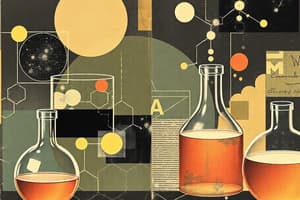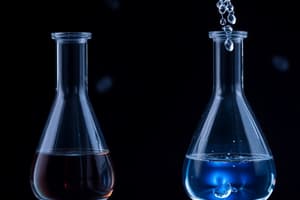Podcast
Questions and Answers
Which of the following best describes the behavior of gas particles?
Which of the following best describes the behavior of gas particles?
- Widely spaced and moving randomly, allowing for easy compression and no fixed shape or volume. (correct)
- Closely packed but able to move past each other, maintaining a fixed volume but not a fixed shape.
- Arranged in a regular lattice structure, vibrating in fixed positions.
- Closely packed with strong attractions, maintaining a fixed shape and volume.
What distinguishes a compound from a mixture?
What distinguishes a compound from a mixture?
- A compound consists of only one type of atom, while a mixture contains multiple types.
- A compound is chemically bonded, while a mixture is physically combined. (correct)
- A compound can be separated by physical means, while a mixture requires chemical reactions for separation.
- A compound is physically combined, while a mixture is chemically bonded.
How does distillation achieve the separation of liquids?
How does distillation achieve the separation of liquids?
- By evaporating the liquid, leaving behind any dissolved solids.
- By using a filter to trap insoluble particles, leaving the liquid behind.
- By exploiting differences in boiling points to selectively vaporize and condense the liquids. (correct)
- By using a solvent to dissolve specific components of the mixture.
What determines the identity of an element?
What determines the identity of an element?
How do isotopes of the same element differ?
How do isotopes of the same element differ?
Why do elements in the same group of the periodic table exhibit similar chemical properties?
Why do elements in the same group of the periodic table exhibit similar chemical properties?
What type of bond is formed through the sharing of electrons between two nonmetals?
What type of bond is formed through the sharing of electrons between two nonmetals?
What is the significance of balancing chemical equations?
What is the significance of balancing chemical equations?
A chemist mixes 2.0 grams of hydrogen ($H_2$) with 16.0 grams of oxygen ($O_2$) and causes the reaction $2H_2 + O_2
ightarrow 2H_2O$ to occur. If the reaction goes to completion, which is the limiting reactant?
A chemist mixes 2.0 grams of hydrogen ($H_2$) with 16.0 grams of oxygen ($O_2$) and causes the reaction $2H_2 + O_2 ightarrow 2H_2O$ to occur. If the reaction goes to completion, which is the limiting reactant?
What information is needed to calculate the molar concentration of a solution?
What information is needed to calculate the molar concentration of a solution?
What products are formed in a neutralization reaction?
What products are formed in a neutralization reaction?
What happens to anions during electrolysis?
What happens to anions during electrolysis?
Consider the reaction: $N_2(g) + 3H_2(g)
ightarrow 2NH_3(g)$. If the reaction vessel is cooled, favoring the forward reaction, is this an endothermic or exothermic reaction?
Consider the reaction: $N_2(g) + 3H_2(g) ightarrow 2NH_3(g)$. If the reaction vessel is cooled, favoring the forward reaction, is this an endothermic or exothermic reaction?
Which process involves a substance changing directly from a solid to a gas, bypassing the liquid phase?
Which process involves a substance changing directly from a solid to a gas, bypassing the liquid phase?
How does a catalyst increase the rate of a chemical reaction?
How does a catalyst increase the rate of a chemical reaction?
Which of the following properties is generally characteristic of metals?
Which of the following properties is generally characteristic of metals?
What is the role of valence electrons in chemical bonding?
What is the role of valence electrons in chemical bonding?
What is the pH of a neutral solution?
What is the pH of a neutral solution?
Which separation technique is most suitable for isolating a soluble solid from a liquid?
Which separation technique is most suitable for isolating a soluble solid from a liquid?
In an electrolytic process, what type of chemical reaction occurs at the anode?
In an electrolytic process, what type of chemical reaction occurs at the anode?
Flashcards
What is Chemistry?
What is Chemistry?
The study of matter and its properties, including how matter changes.
What are the common states of matter?
What are the common states of matter?
Solid, liquid, and gas. These are dependent on the spacing and forces between particles.
What is an atom?
What is an atom?
The smallest unit of an element that retains the chemical properties of that element.
What is an element?
What is an element?
Signup and view all the flashcards
What is a compound?
What is a compound?
Signup and view all the flashcards
What is a mixture?
What is a mixture?
Signup and view all the flashcards
What is Filtration?
What is Filtration?
Signup and view all the flashcards
What is Evaporation?
What is Evaporation?
Signup and view all the flashcards
What is Distillation?
What is Distillation?
Signup and view all the flashcards
What is the atomic number?
What is the atomic number?
Signup and view all the flashcards
What is the mass number?
What is the mass number?
Signup and view all the flashcards
What are isotopes?
What are isotopes?
Signup and view all the flashcards
What are groups (on the periodic table)?
What are groups (on the periodic table)?
Signup and view all the flashcards
What are periods (on the periodic table)?
What are periods (on the periodic table)?
Signup and view all the flashcards
What are metals?
What are metals?
Signup and view all the flashcards
What are nonmetals?
What are nonmetals?
Signup and view all the flashcards
What are chemical bonds?
What are chemical bonds?
Signup and view all the flashcards
What are ionic bonds?
What are ionic bonds?
Signup and view all the flashcards
What are covalent bonds?
What are covalent bonds?
Signup and view all the flashcards
What are reactants?
What are reactants?
Signup and view all the flashcards
Study Notes
No new information found. The provided texts are identical.
Studying That Suits You
Use AI to generate personalized quizzes and flashcards to suit your learning preferences.




